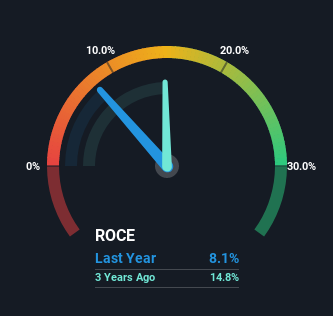- United Kingdom
- /
- Medical Equipment
- /
- LSE:SN.
There Are Reasons To Feel Uneasy About Smith & Nephew's (LON:SN.) Returns On Capital

If you're looking for a multi-bagger, there's a few things to keep an eye out for. Amongst other things, we'll want to see two things; firstly, a growing return on capital employed (ROCE) and secondly, an expansion in the company's amount of capital employed. Basically this means that a company has profitable initiatives that it can continue to reinvest in, which is a trait of a compounding machine. In light of that, when we looked at Smith & Nephew (LON:SN.) and its ROCE trend, we weren't exactly thrilled.
Understanding Return On Capital Employed (ROCE)
If you haven't worked with ROCE before, it measures the 'return' (pre-tax profit) a company generates from capital employed in its business. To calculate this metric for Smith & Nephew, this is the formula:
Return on Capital Employed = Earnings Before Interest and Tax (EBIT) ÷ (Total Assets - Current Liabilities)
0.081 = US$712m ÷ (US$11b - US$2.1b) (Based on the trailing twelve months to December 2021).
So, Smith & Nephew has an ROCE of 8.1%. In absolute terms, that's a low return but it's around the Medical Equipment industry average of 10%.
Check out our latest analysis for Smith & Nephew

Above you can see how the current ROCE for Smith & Nephew compares to its prior returns on capital, but there's only so much you can tell from the past. If you'd like, you can check out the forecasts from the analysts covering Smith & Nephew here for free.
What Does the ROCE Trend For Smith & Nephew Tell Us?
On the surface, the trend of ROCE at Smith & Nephew doesn't inspire confidence. Over the last five years, returns on capital have decreased to 8.1% from 15% five years ago. Although, given both revenue and the amount of assets employed in the business have increased, it could suggest the company is investing in growth, and the extra capital has led to a short-term reduction in ROCE. And if the increased capital generates additional returns, the business, and thus shareholders, will benefit in the long run.
The Bottom Line
While returns have fallen for Smith & Nephew in recent times, we're encouraged to see that sales are growing and that the business is reinvesting in its operations. In light of this, the stock has only gained 0.9% over the last five years. So this stock may still be an appealing investment opportunity, if other fundamentals prove to be sound.
Smith & Nephew could be trading at an attractive price in other respects, so you might find our free intrinsic value estimation on our platform quite valuable.
While Smith & Nephew may not currently earn the highest returns, we've compiled a list of companies that currently earn more than 25% return on equity. Check out this free list here.
New: Manage All Your Stock Portfolios in One Place
We've created the ultimate portfolio companion for stock investors, and it's free.
• Connect an unlimited number of Portfolios and see your total in one currency
• Be alerted to new Warning Signs or Risks via email or mobile
• Track the Fair Value of your stocks
Have feedback on this article? Concerned about the content? Get in touch with us directly. Alternatively, email editorial-team (at) simplywallst.com.
This article by Simply Wall St is general in nature. We provide commentary based on historical data and analyst forecasts only using an unbiased methodology and our articles are not intended to be financial advice. It does not constitute a recommendation to buy or sell any stock, and does not take account of your objectives, or your financial situation. We aim to bring you long-term focused analysis driven by fundamental data. Note that our analysis may not factor in the latest price-sensitive company announcements or qualitative material. Simply Wall St has no position in any stocks mentioned.
About LSE:SN.
Smith & Nephew
Develops, manufactures, markets, and sells medical devices and services in the United Kingdom, the United States, and internationally.
Established dividend payer and good value.
Similar Companies
Market Insights
Community Narratives



